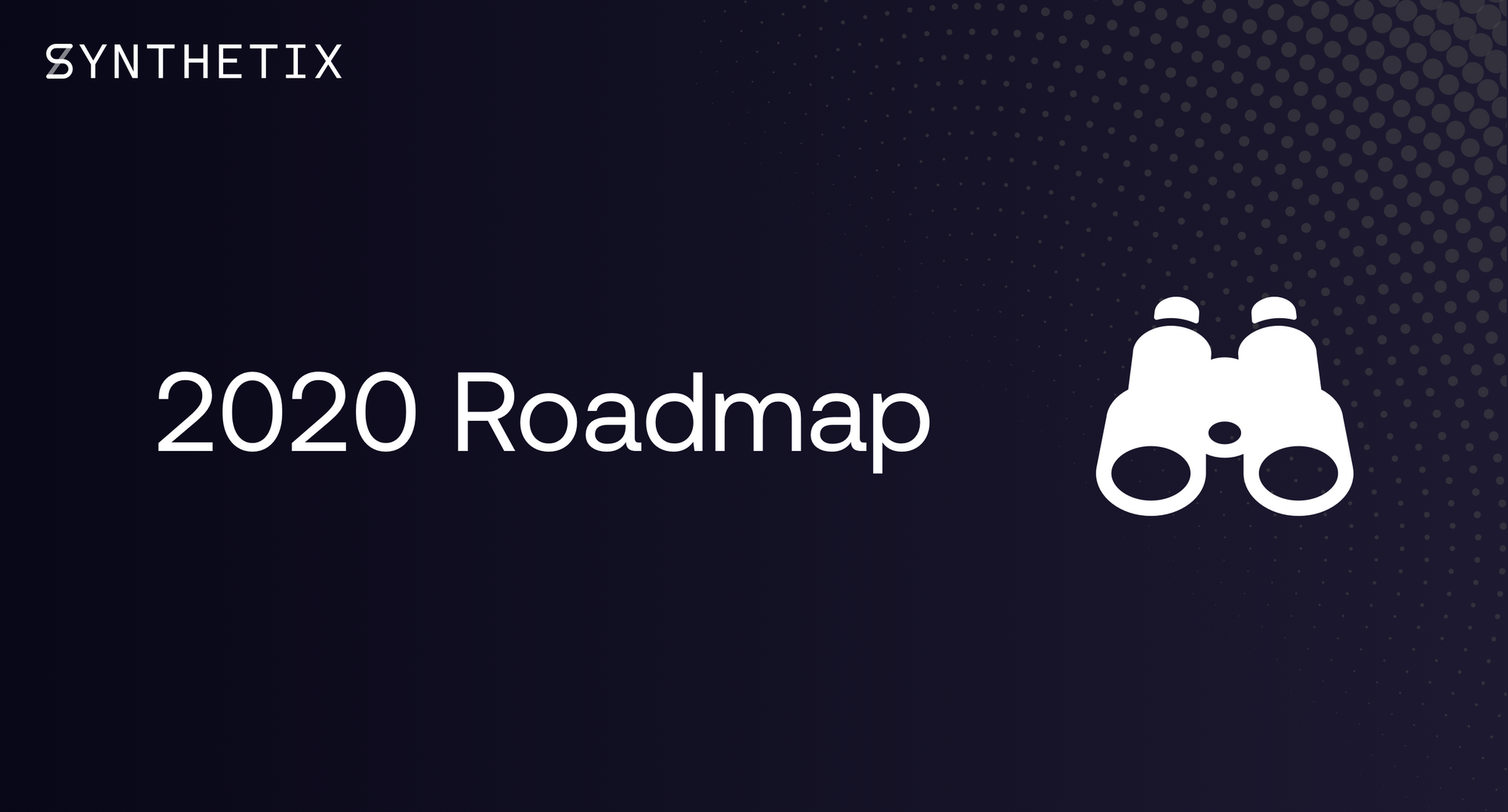2020 Roadmap
A look ahead at everything Synthetix plans to achieve this year

Last Updated Feb 28th 2020
If you’re reading this, you probably already know 2019 was a huge year for Synthetix. With the community’s growing involvement, the team delivered a consistent stream of protocol improvements and saw major traction across a range of metrics. To recap, here’s an incomplete list of some of the bigger items that were delivered in 2019:
- Nearly $1b in trading volume on Synthetix.Exchange (since surpassed)
- Rapid growth in the SNX collateral value
- SNX staking rewards launched, leading to 80% staking participation
- Uniswap staking rewards, leading to the largest liquidity pool on Uniswap
- Inverse Synths allowing traders to take short positions
- The first phase of decentralised governance
- The first phase of decentralised oracles
- Numerous dApp upgrades
- Community-led changes to the monetary policy
- Opening up development to the community through bounties, Gitcoin, etc.
We’re pleased with what we achieved, but it will mean very little unless we continue to deliver in 2020. This post will outline everything we currently plan to deliver this year, including some of the motivations for our choices. As part of the process for determining the priorities this year, we ran a poll among in Discord to signal what should be focused on, both at a high level and in more detail. We’ve used that feedback to shape this plan.
This article goes hand-in-hand with a partner piece written by Kain about the current state of the Synthetix system, which you can read here. That post provides context on why we’re prioritising specific categories and features, if you wish to understand the reasoning behind these items you should read it first. It also outlines the current risks within the system that must be resolved before we can gain a substantial share of the trading market. Solving these issues will be the focus for the next few releases.
Most of the items in the next three releases have been written up as either issues or SIPs in our public Github repo, so we won’t unpack them further here. After that, we’ll outline the rest of the items we plan to achieve this year.
These release details are proposals only and are subject to change via community consensus.
Achernar release - February 20th 2020
- Uniswap staking rewards (SIP-31)
- Remove XDR (SIP-33)
- Skinny ETH collateral (SIP-35)
- Fee reclamation (Issue-57)
- Production: sX v2
- Two Foundation-funded trials (pending community approval):
- SNX staking incentives (Issue-74)
- SNX auctions (Issue-76)
Betelgeuse release - February 28th 2020
- Frontminting prevention (SIP TBC)
- ProtocolDAO phase zero (SIP TBC)
Hadar release - Late March 2020
- Improved delegation powers (SIP-10)
- Continuous rewards (Issue-58)
- One-week claim window (SIP-9)
- Chainlink Phase 2 (SIP-36)
- Synth exchange pausing (Issue-79)
- ProtocolDAO phase one
While we progress these releases, the community must debate and discuss the remaining items on the roadmap, as well as any unplanned priorities, in order to crystallise later releases. Each item category is listed in order of the community’s preferences, as well as item level preferences.
Growth / adoption
Additional crypto Synths (including leveraged Synths)
Leveraged ERC-20 Synths are important because they can be composed into other DeFi systems, ensuring wider distribution.
Synthetic assets and indices
Once the current assets feeds have been migrated to Chainlink and once the project has transitioned to a DAO the ability for the community to request new asset classes (including stocks and indices) is unblocked.
Synthetic positions
Synthetic positions enable leveraged trading and will implement position maintenance costs to incentivise a more market neutral debt pool.
Binary options
Binary options that offer a transparent market for hedging macro price movements are likely to be a highly valuable trading tool and could generate significant sX volume.
Website upgrade
The website no longer reflects the current state of the project. A refresh is required.
Mechanism / incentive design
Ether collateral
Once a three-month trial period with ‘skinny’ Ether collateral is complete, we will launch the full Ether collateral functionality with liquidation, interest rates and other features.
Additional Uniswap incentives (Issue-74)
There are further Uniswap pools we can incentivise to improve Synth liquidity. Chief among them is SNX-ETH liquidity, when Uniswap v2 is out we can also add a sUSD-DAI pool.
Depot upgrades
The current ‘first-in-first-out’ Depot mechanism is not ideal. By implementing a pooled Depot, depositing sUSD will provide more utility for SNX stakers. If we add additional incentives to depositing into this pool it will likely also increase the circulating Synth supply.
User experience
Layer 2 solutions (Optimistic Rollups)
Ethereum L1 introduces a number of issues for sX trading. Implementing Optimistic Rollups will allow for much higher throughput and an improved trading experience.
Triggered orders (Issue-195)
Triggered orders will radically improve the trading experience on sX. Stop-loss, limit and other order types are crucial to providing a feature-complete exchange.
SNX staking pools (Issue-192)
The ability to delegate SNX staking to a pool manager will allow users who are not confident in maintaining their positions to rely on a dedicated staking manager for a fee.
ERC-20 Escrow tokens
Allowing minters to create an ERC-20 IOU token for escrowed SNX could solve a major UX issue for centralised services that provide staking services to their users, CEXs in particular. Early stage discussions.
Protocol security
Market closure pausing
Some markets (including forex) pause for certain periods. It’s important that we introduce a mechanism to prevent traders from being able to benefit when there’s an expected price spike during a market closure.
Tracking trading profit
Tracking the P/L of individual wallets is important both for system monitoring as well as for providing information to traders on sX.
Unit test audit
After all we delivered throughout 2019, the system has accrued some technical debt which will need to be repaid.
Adding pause functionality to our contracts
The addition of a time delay means in an emergency scenario the contracts must be pausable, the proposed solution is to allow any signer of the ProtocolDAO to pause the contracts for n hours, additional signers must also submit a pause tx to extend this if required.
Decentralisation
Decentralised proxies (Issue-235)
Decentralised proxy contracts will ensure future upgrades to the system are controlled by a DAO and can be vetoed under certain conditions by token holders.
DAO phase 1 (blog)
Migration to a DAO structure is critical to ensuring the protocol can continue to innovate and push the boundaries of synthetic asset issuance on Ethereum.
ProtocolDAO (blog)
Governance of protocol upgrades must be enhanced to improve the security and transparency of the system, this includes a time delay for upgrades and a mechanism to publish the proposed protocol upgrades on-chain prior to execution.
Upgrading The Graph
Upgrading The Graph will allow the dApps to be deployed to IPFS ensuring there is not a central point of failure for the interfaces.
System optimisation
Optimise ‘total issued Synths’
Calculating total issued Synths uses significant gas, by refactoring and optimising these calls the cost of mint/burn tx will be reduced significantly.
Upgraded staking mechanism
This is a highly theoretical approach to solving some of the existing issues within the contract architecture by abstracting the staking logic out of the token contract.
Synthetix contract refactor
The current contract size means there is little room for additional functionality. Refactoring the contract is important technical debt that must be addressed.
Deployment upgrades
The current deployment process requires significant overhead, streamlining the deployment process will reduce overhead and downtime during upgrades.
Contract address resolver
Creating a single reference to each contract will enable easier external integrations as well as more streamlined protocol upgrades.
Composability
Migrate to new SNX, sUSD ERC20 Proxies (emit all transfer events)
This is a technical debt issue, ensuring all Synths use the same proxy architecture.
Improved documentation
The current documentation needs to be updated to ensure external teams integrating the protocol have updated and comprehensive documentation.
Conclusion
2020 is shaping up to be a huge year for Synthetix. We spent the back-end of 2019 trialling rough consensus within our community for governance decisions, and we’ll be continuing that process this year. This will include using the community’s input to prioritise the items for any releases after Hadar, whether it’s through Discord or on our governance calls.
If you’ve got any questions about anything you see here, we’ve got a community governance call in a few hours from time of publication, which we’d love for you to join us on, or you can also come join the conversation on Discord!

